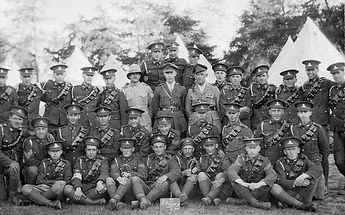
_Field_Artillery_.png)
1st Field Regimental Association

84th Independent Field Battery in 1927
84th Independent Field Battery
During the war of 1812-1814, between England and the United States, some raiders appeared on the coast near Yarmouth and on one of the landings one of the inhabitants was killed. For their protection the people of Yarmouth formed a Company of Militia volunteers, with a headquarters at Bunker Island, in Yarmouth Harbour. This island was frequently used as a training ground later on.
Yarmouth has the distinction of having formed the first Company of rifle volunteers, in what is now the Dominion of Canada. They also received the first “Issue of Arms” on July 29, 1857. Captain J. W. H. Rowley, whose commission bears the date of 1859, then commanded this company. In the report of the 100th celebration of the founding of Yarmouth, which took place on 10 June 1861, the Artillery Company firing a salute ushered the day in.
In celebration of the Coronation of Queen Victoria on June 28, 1838, the Yarmouth Artillery Company fired a salute from the Blockhouse on Milton Heights and also from Bunker Island. His Excellency the Earl of Musgrave arrived in Yarmouth aboard the HMS Gladiator on September 7, 1861, for the purpose of inspecting the Volunteer Rifle Company.
The company was authorized on 4 October 1878 as the Yarmouth Battery of Garrison Artillery. On August 12, 1880, a Guard of Honour was formed by the artillery company upon the arrival of his Excellency the Marquis of Lorne, at Yarmouth. The Quarterly Militia List of Canada, July 1st, 1899, shows this unit as being No. 8 Company, Garrison Artillery, 2nd Division, Yarmouth, Nova Scotia. This Company of Garrison Artillery formed a Guard of Honour during the visit to Yarmouth of Lord and Lady Aberdeen August 27th 1894. A copy of the Service roll 1892 shows the manning to be; 3 officers, 4 senior NCO’s, 2 corporals, 2 bombardiers and 27 gunners.
In 1912 service rolls, the unit is listed as 29th Battery, 11th Brigade, C.F.A. This unit was continued as the 29th Field Battery, C.F.A. until December 1st 1920 at which time it was reorganized as the 84th Field Battery (How) of the 14th Brigade, C.F.A. During the war 1914-1918, the personnel of the Yarmouth Battery served overseas with many different units, many of them with distinction. The mobilization of the 84th Battery was authorized 20 January 1916, as the 49th Battery, C.
F. A. and was recruited in St. Catherines, Ontario. On the 12th of October 1916, the Privy Council Orders changed the unit designation to 84th Battery, C. F. A. The battery was mobilized in Toronto Militia District, and preceded to Camp Petawawa for training. After three months of extensive fieldwork the battery was moved to Amherst, Nova Scotia. On the 11th of September1916, the battery embarked from Halifax on board the “S.S. Cameronia”, and sailed for England on the 15th of September 1916, arriving at Liverpool on 22nd September 1916. It was organized as part of the 12th Brigade, C. F. A. until the 6th of October that year when the designation was changed to the 16th Brigade, C. F. A. Then on the 22nd of January 1917 the battery was split up into drafts, one half being absorbed into the 82nd Battery and the other half into the 83rd Battery of the 15th Brigade, C. F. A. Both batteries arrived in France in the 20th of March 1917.
After the war the 84th Howitzer Battery was re-organized with the HQ at Yarmouth. The unit strength at this time was 7 Officers and 70 other ranks. For the first couple of years training commenced at the Yarmouth Armories on June 19th 1922. On the 20th of June the unit with 36 all ranks went to Camp Petawawa for annual training.
During the period of 1922-1939 the battery carried out local training as well participation in annual artillery practice camps at Camp Petawawa. As participants in gunners’ competitions and sport events the battery won numerous trophies and awards. Also members of the unit participated in many ceremonial parades and inspections. One of note is one OR was selected to attend the Coronation of King George VI at London England. The selected soldier was BSM JW Breen.
Then under G. O. 92-1939 the unit was converted to the 6th Anti-Aircraft Battery RCA effective June 1st 1939.
During this re-organization 14th Field Regiment located its HQ at Yarmouth and “87” Battery at Kentville, and 88th Battery at Windsor. On September 1st 1939 orders were received by telegraph to mobilize the 6th AA Battery to full peace establishment. In Jul 1940 soldiers were recruited and trained for overseas duty with 87th and 88th Batteries. This unit was equipped with 18-pounders and had numerous personnel from Yarmouth. The 87th and 88th Batteries were re-organized as 88th Light Anti-Aircraft Battery, and equipped with 40mm Bofors. It formed part of the 1st Canadian Armored Division and was in action in the Battle of Britain and later in the Italian and Belgium theatres.
In 1942 NDHQ decided it was necessary for the Reserve Army in Nova Scotia to have Artillery support and the 14th Field Regiment (M) was formed with its HQ at Yarmouth and 52nd Battery at Lockport, 84th Battery at Yarmouth and the 87th Battery at Dartmouth. The Battery was issued 18-pounders and training commenced. As the opening of the British Front in Europe had apparently put to an end to any possible attempt of the enemy to land troops in this country, LCol O.E. Dyke submitted a recommendation to reserve HQ that in interest to the economy the 14th Field Regiment RCA (M) be disbanded. Effective 21 January 1944 the unit became dormant.
A few points to note during the war years, the West NS Regiment had D Company in Yarmouth to provide a Home Guard, and in 1940 the Canadian Army (Basic) Training Center was set up in Yarmouth and it is said that approximately 10 000 troops trained here.
On April 1st 1946 the 14th Field regiment RCA (M) was reformed with the HQ and 84th Battery at Yarmouth, 152nd Battery at Shelburne and 133rd Battery at Liverpool. The Regiment was equipped with 25-pounders. At this time all of the officer’s have all had Active service experience, and all three services are represented; Navy, Army, and Air Force. This proved beneficial in their training as artillery officers."
On 30 June 1968, the 14th Field regiment was disbanded and 84th Independent Field Battery, RCA was formed. In the early 2000s, 87th Independent Battery and 1st Field Regiment were amalgamated by operational command. Today, the senior batteries of the regiment consist of 51st Battery, and 87th Independent Battery.





